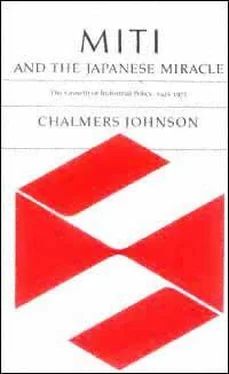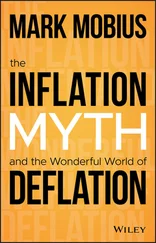Chalmers Johnson - MITI and the Japanese miracle
Здесь есть возможность читать онлайн «Chalmers Johnson - MITI and the Japanese miracle» весь текст электронной книги совершенно бесплатно (целиком полную версию без сокращений). В некоторых случаях можно слушать аудио, скачать через торрент в формате fb2 и присутствует краткое содержание. Год выпуска: 2007, Издательство: Stanford University Press, Жанр: Старинная литература, на английском языке. Описание произведения, (предисловие) а так же отзывы посетителей доступны на портале библиотеки ЛибКат.
- Название:MITI and the Japanese miracle
- Автор:
- Издательство:Stanford University Press
- Жанр:
- Год:2007
- ISBN:нет данных
- Рейтинг книги:3 / 5. Голосов: 1
-
Избранное:Добавить в избранное
- Отзывы:
-
Ваша оценка:
- 60
- 1
- 2
- 3
- 4
- 5
MITI and the Japanese miracle: краткое содержание, описание и аннотация
Предлагаем к чтению аннотацию, описание, краткое содержание или предисловие (зависит от того, что написал сам автор книги «MITI and the Japanese miracle»). Если вы не нашли необходимую информацию о книге — напишите в комментариях, мы постараемся отыскать её.
MITI and the Japanese miracle — читать онлайн бесплатно полную книгу (весь текст) целиком
Ниже представлен текст книги, разбитый по страницам. Система сохранения места последней прочитанной страницы, позволяет с удобством читать онлайн бесплатно книгу «MITI and the Japanese miracle», без необходимости каждый раз заново искать на чём Вы остановились. Поставьте закладку, и сможете в любой момент перейти на страницу, на которой закончили чтение.
Интервал:
Закладка:
The national-character explanation argues that the economic miracle occurred because the Japanese possess a unique, culturally derived capacity to cooperate with each other. This capacity to cooperate reveals itself in many wayslower crime rates than in other, less homogeneous societies; subordination of the individual to the group; intense group loyalties and patriotism; and, last but not least, economic performance. The most important contribution of the culture to economic life is said to be Japan's famous "consensus," meaning virtual agreement among government, ruling political party, leaders of industry, and people on the primacy of economic objectives for the society as a wholeand on the means to obtain those objectives. Some of the terms invented to refer to this cultural capability of the Japanese are "rolling consensus,"
6
''private collectivism,"
7
"inbred collectivism,"
8
"spiderless cobweb,"
9
and "Japan, Inc."
10
My reservations about the value of this explanation are basically that it is overgeneralized and tends to cut off rather than advance serious research. Consensus and group solidarity have been important in Japan's economic growth, but they are less likely to derive from the basic values of the Japanese than from what Ruth Benedict once called Japan's "situational" motivations: late development, lack of resources, the need to trade, balance of payments constraints, and so forth.
11
Positing some "special capacity to cooperate" as an irreducible Japanese cultural trait leads inquiry away from the question of
why
Japanese cooperate when they do (they did not cooperate during almost half of the period under study here), and away from the probability that this cooperation can be, and on occasion has been, quite deliberately engineered by the government and others. David Titus's research into the use of the Imperial institution in prewar Japan to "privatize" rather than to "socialize" societal conflict is one creative way to look at this problem of consensus.
12
Many instances to be discussed later in this study illustrate how the government has consciously induced cooperation among its clientswith much better results than during the Pacific War, when it sought to control them. In the final analysis it is indeed probable that Jap-
Page 9
anese basic values are different from those of the Western world, but this needs to be studied, not posited; and explanations of social behavior in terms of basic values should be reserved for the final analysis, that is, for the residue of behavior that cannot be explained in other more economical ways. Actually, the explanation of the Japanese economic miracle in terms of culture was more prevalent a few years ago, when the miracle had occurred only in Japan. Now that it is being duplicated or matched in the Republic of Korea, Taiwan, Hong Kong, and Singaporeand perhaps even in some non-East Asian nationsthe cultural explanation has lost much of its original interest.
13
Exemplars of the "no-miracle-occurred" school of analysis do not literally assert that nothing happened to Japan's economy, but they imply that what did happen was not miraculous but a normal out growth of market forces. They come from the realm of professional economic analyses of Japanese growth, and therefore in their own terms are generally impeccable, but they also regularly present extended conclusions that incorporate related matters that their authors have not studied but desperately want to exclude from their equations. Hugh Patrick argues, "I am of the school which interprets Japanese economic performance as due primarily to the actions and efforts of private individuals and enterprises responding to the opportunities provided in quite free markets for commodities and labor. While the government has been supportive and indeed has done much to create the environment for growth, its role has often been exaggerated."
14
But there is a problem, he concedes. "It is disturbing that the macro explanations of Japanese postwar economic performancein terms of increases in aggregate labor and capital inputs and in their more productive allocationleave 40 percent plus of out put growth and half of labor productivity growth unexplained."
15
If it can be shown that the government's industrial policy made the difference in the rate of investment in certain economically strategic industries (for instance, in developing the production and successful marketing of petrochemicals or automobiles), then perhaps we may say that its role has not been exaggerated. I believe this can be demonstrated and I shall attempt to do so later in this study.
Many Japanese would certainly dispute Patrick's conclusion that the government provided nothing more than the environment for economic growth. Sahashi Shigeru, former vice-minister of MITI (the Ministry of International Trade and Industry), asserts that the government is responsible for the economy as a whole and concludes, "It is an utterly self-centered [businessman's] point of view to think that the government should be concerned with providing only a favorable en-
Page 10
vironment for industries without telling them what to do."
16
There have been occasions when industries or enterprises revolted against what the government told them to doincidents that are among the most sensational in postwar politicsbut they did not, and do not, happen often enough to be routine.
Discussions of the Japanese economy in purely economic terms seem to founder on their assumptions rather than on their analyses. It is assumed, for example, that the Japanese developmental state is the same thing as the American regulatory state. Philip Trezise argues, "In essentials, Japanese politics do not differ from politics in other democracies."
17
But one way they differ is in a budgetary process where appropriations
precede
authorizations and where, "with the single exception of 1972, when a combination of government mishandling and opposition unity led to small reductions in defense spending, the budget has not been amended in the Diet since 1955"; before that there was no pretense that the Diet did anything more than rubber-stamp the bureaucracy's budget.
18
Another difference between Japan and the United States is to be found in the banking system. Before the war the rate of owned capital of all corporations in Japan was around 66 percenta rate comparable to the current U.S. rate of 52 percentbut as late as 1972 the Japanese rate of owned capital was around 16 percent, a pattern that has persisted throughout the postwar period. Large enterprises obtain their capital through loans from the city banks, which are in turn over loaned and therefore utterly dependent on the guarantees of the Bank of Japan, which is itselfafter a fierce struggle in the 1950's that the bank lostessentially an operating arm of the Ministry of Finance. The government therefore has a direct and intimate involvement in the fortunes of the "strategic industries" (the term is standard and widely used, but not in the military sense) that is much greater than a formal or legal comparison between the Japanese and other market systems would indicate. MITI was not just writing advertising copy for itself when in 1974 it publicly introduced the concept of a "plan-oriented market economy system," an attempt to name and analyze what it had been doing for the previous twenty years (the twenty years before that it had spent perfecting the system by trial and error).
19
The plan-oriented market economy system most decidedly includes some differences from "politics in other democracies," one of them being the care and feeding of the economic miracle itself.
The "no-miracle-occurred" school of miracle researchers agrees that Japanese economic growth took place but insists that this was because of the availability of capital, labor, resources, and markets all
Читать дальшеИнтервал:
Закладка:
Похожие книги на «MITI and the Japanese miracle»
Представляем Вашему вниманию похожие книги на «MITI and the Japanese miracle» списком для выбора. Мы отобрали схожую по названию и смыслу литературу в надежде предоставить читателям больше вариантов отыскать новые, интересные, ещё непрочитанные произведения.
Обсуждение, отзывы о книге «MITI and the Japanese miracle» и просто собственные мнения читателей. Оставьте ваши комментарии, напишите, что Вы думаете о произведении, его смысле или главных героях. Укажите что конкретно понравилось, а что нет, и почему Вы так считаете.












